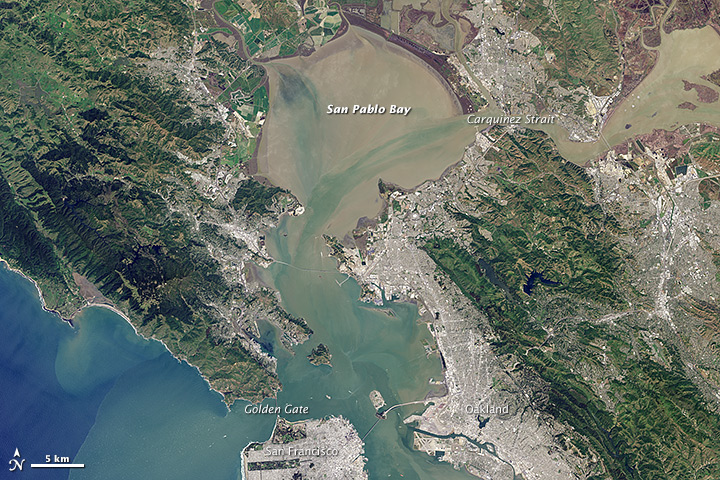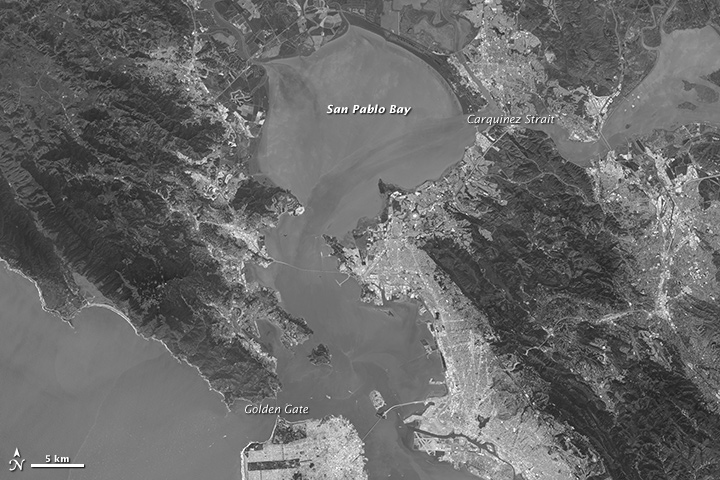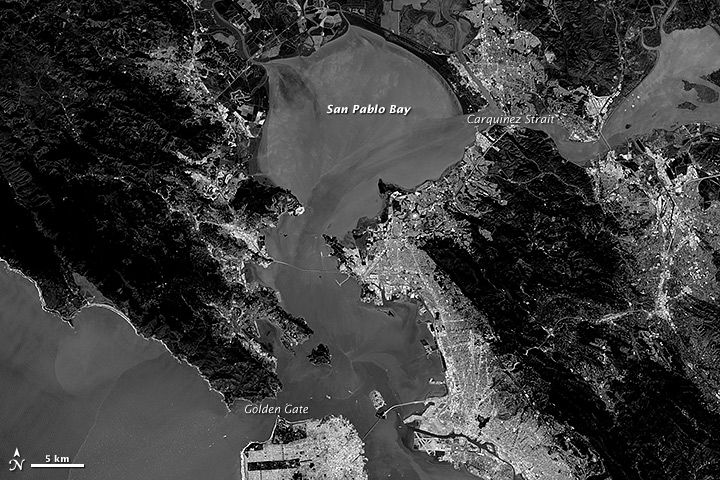
natural color (with coastal blue)
acquired April 16, 2013
download large natural color (with coastal blue) image (5 MB, JPEG, 3276x3276)
acquired April 16, 2013
download natural color (with coastal blue) GeoTIFF file (25 MB, TIFF)

coastal blue
acquired April 16, 2013
download large coastal blue image (3 MB, JPEG, 3276x3276)
acquired April 16, 2013
download coastal blue GeoTIFF file (9 MB, TIFF)

blue
acquired April 16, 2013
download large blue image (3 MB, JPEG, 3276x3276)
acquired April 16, 2013
download blue GeoTIFF file (9 MB, TIFF)
acquired April 16, 2013
download Google Earth file (KML)
Satellite observations of Earth’s
land and ice surfaces and the open ocean have been incredibly valuable
for understanding the processes and rhythms of our planet. But at the
intersection of land and sea, many imaging techniques and analyses can
get muddy.
For remote sensing scientists, coastal waters are a productive,
murky, fascinating, and frustrating mess. Salt water meets fresh. Waters
rise and fall and get mixed constantly by waves, winds, eddies, and
other turbulence. The visible boundaries between ocean and land move on
scales from hours to seasons to decades. Even the atmosphere gets murky,
as moisture, pollution, and airborne particles are more abundant and
dynamic than over open water. And light plays off all of these surfaces,
solid and liquid.
The newest satellite in the Landsat series offers scientists a clearer view. The Landsat Data Continuity Mission—officially renamed Landsat 8 on May 30, 2013—has better spatial resolution than most ocean-sensing instruments and greater sensitivity to brightness and color
than previous Landsats. Most significantly, it can observe the Earth in
wavelengths that allows scientists to adjust for the distortions caused
by the atmosphere near the coast.
The images above were collected by the Operational Land Imager (OLI) on Landsat 8
on April 16, 2013, while the satellite was still being calibrated and
checked out. The top image shows San Pablo Bay and the north end of San
Francisco Bay in natural color. The two lower images show the same area
in specific spectral bands or wavelengths:
the shortwave, ultra-blue “coastal” band at 0.43–0.45 micrometers
(second image) and the “blue” band at 0.45–0.51 micrometers (third
image).
Note how plumes of sediment and other features in the water are less
distinct and have less contrast in the coastal band than the blue band.
The coastal band is sensitive to aerosols and other atmospheric effects
that scatter light and make the view of San Francisco Bay seem hazy. By
comparing the coastal blue and the blue bands, scientists can then
correct for the difference and get a better view of what is happening at
the water surface instead of in the air.
“These images show of the complexity of the problem in soupy coastal
waters,” said John Schott, a member of the Landsat science team and a
professor at the Rochester Institute of Technology. Landsat 8 should
help researchers make much more accurate observations of sediments and
particles, organic matter, and the chlorophyll-rich phytoplankton suspended in lakes, rivers, and the ocean. It may even help researchers make quantitative measurements.
The coastal blue band on Landsat 8 is comparable to wavelengths
observed by the Moderate Resolution Imaging Spectroradiometer (MODIS) on
the Aqua and Terra satellites, by the Visible Infrared Imaging Radiometer on Suomi NPP, and by the Sea-viewing Wide Field-of-view Sensor (SeaWiFS) on SeaStar. However, Landsat 8 improves upon those sensors with better spatial resolution and dynamic range.
“With the new coastal band, there is a good chance to estimate carbon
exchange at the land-water interface—such as salt marshes, wetlands,
harbors—where ocean color instruments fail due to coarse pixel size,”
said Nima Pahlevan, a researcher at the University of
Massachusetts–Boston. “That said, the retrieval of chlorophyll and
colored dissolved organic matter in turbid coastal waters is an ongoing
challenge.”
Schott and Pahlevan also note that Landsat 8 should expand and
improve upon their ability to map some underwater features, such as kelp
and other vegetation, coral reefs, and the bathymetry of shallow
waters.
Further Reading
- NASA Earth Observatory (2013, April 16) Eye Exam for a Satellite.
- NASA Earth Observatory (2012, July 23) Landsat Looks and Sees.
- NASA Landsat Data Continuity Mission. Accessed May 30, 2013.
- NASA The Landsat Program. Accessed May 30, 2013.
- U.S. Geological Survey Landsat. Accessed May 29, 2013.
Images by Jesse Allen
and Robert Simmon, using data provided by the U.S. Geological Survey and
NASA. Caption by Michael Carlowicz.
- Instrument:
- Landsat 8 - OLI
NASA: Brazil - San Pablo bay - Bay Blues - 09.06.13
Ricardo M Marcenaro - Facebook
Blogs in operation of The Solitary Dog:
Solitary Dog Sculptor:
http://byricardomarcenaro.blogspot.com
Solitary Dog Sculptor I:
http://byricardomarcenaroi.blogspot.com
Para:
comunicarse conmigo,
enviar materiales para publicar,
propuestas comerciales:
marcenaroescultor@gmail.com
For:
contact me,
submit materials for publication,
commercial proposals:
marcenaroescultor@gmail.com
My blogs are an open house to all cultures, religions and countries. Be a follower if you like it, with this action you are building a new culture of tolerance, open mind and heart for peace, love and human respect.
Thanks :)
Mis blogs son una casa abierta a todas las culturas, religiones y países. Se un seguidor si quieres, con esta acción usted está construyendo una nueva cultura de la tolerancia, la mente y el corazón abiertos para la paz, el amor y el respeto humano.
Gracias :)

No hay comentarios:
Publicar un comentario